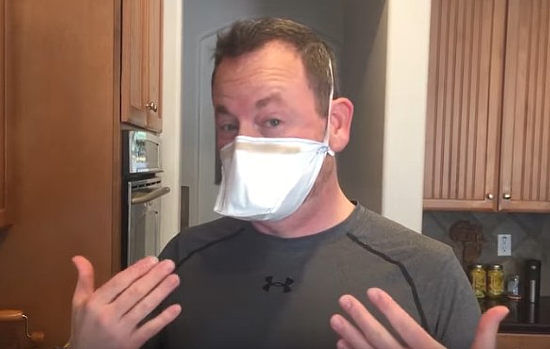This Face Mask Was Designed by a Doctor

A HEPA Filter Makes It Extra Protective!
You don’t need to look far to find a pattern for a face mask. There are many scattered around the internet. In fact, the making of handmade face masks has become something of a movement.
Not only are some hospitals and other health care facilities asking for them, new guidelines suggest we should all wear masks whenever we leave the house. Since they’re hard to come by, many sewists are pitching in to help meet the demand. In fact, PBS New Hour recently ran a segment showcasing the phenomenon.
Click here to watch the video at YouTube if it doesn’t play on your device.
In a previous article we provided mask patterns and tutorials to get you started (you’ll find “Make a Protective Face Mask from Scraps” here). It instigated a lively discussion on Facebook about patterns, materials and more (see the post here).
There are a lot of conflicting opinions about the best designs and materials to use in making masks. The main point to remember is to follow the guidelines provided by the health care providers who will be using them (many hospitals provide patterns).
We recently discovered that Dr. Ryan Southworth has designed a mask pattern with a HEPA filter that filters 99.97% of particulate matter. When fitted and worn properly, that’s even more protective than the N95 masks that are recommended.
While we make no claims whatsoever about the effectiveness and safety of this mask, we have done our best to provide accurate information so you can decide whether or not it’s right for you, your family, friends and local health care providers.
The masks are constructed from vacuum cleaner bags, pipe cleaners and elastic. While some vacuum bags contain fiberglass, apparently those that don’t are safe to use in masks. Look for cloth bags with high filtration (95% or higher) made without fiberglass.
Dr. Southworth specifies Hoover HEPA Vacuum Bags (type Y was used in the demo). According to this video by Super Stitch Sewing other effective and safe choices are Miele U Bags and bags by Enviro Care (Kenmore canister type C and Q was specified). According to them Polypropylene Filter Fabric can also be safely used (look for nonwoven melt blown fabric that filters at least 95% of particles).
The video mentioned above provides a lot of great info about using vacuum bags for masks, saying they wash well and more. Be sure to check it out.
Unfortunately the right vacuum bags are becoming hard to find so check local sources and make sure the bags say HEPA (or that they capture 99.9% of dust or allergens). Micro filtration bags are not as protective.
Also, make sure they are cloth bags and look for those that are made using 3M’s Filtrete unwoven melt blown electrostically charged polypropylene filters (the same type as in 3M N95 mask filters).
In the following video Dr. Southworth’s wife demonstrates how to make the masks. Be sure to follow all of her safety precautions, including to avoid pins (they poke holes that viruses can get through). Also, we recommend not using your good fabric scissors when making these masks.
Click here to watch the video at YouTube if it doesn’t play on your device.
In the video, 1/2″ elastic is cut in half lengthwise. This is a good solution if you can’t find 1/4″ elastic, but it does weaken the elastic so the masks may not hold up as well. Since the elastic on these masks go around the head rather than the ears, they’re more comfortable for extended wear. Fabric ties are also a good option. If you’ll be donating the masks be sure to check with the recipients to learn what they prefer.
It has been pointed out that stitching lines also poke holes. You may want to seal them with a thin bead of hot gun glue, beeswax, fusible interfacing or even tent seam sealer.












